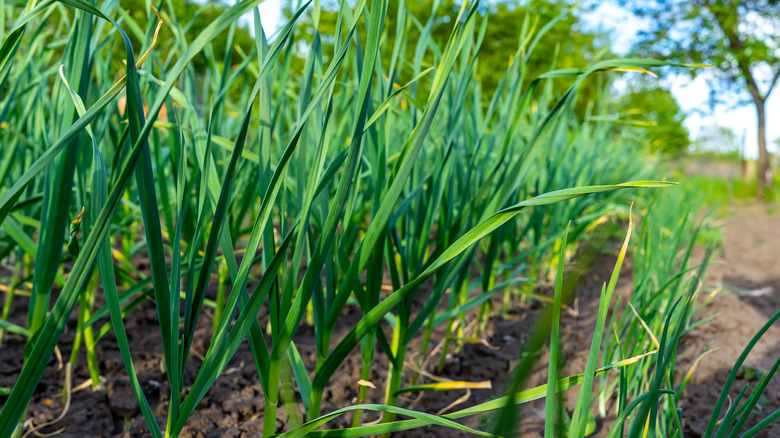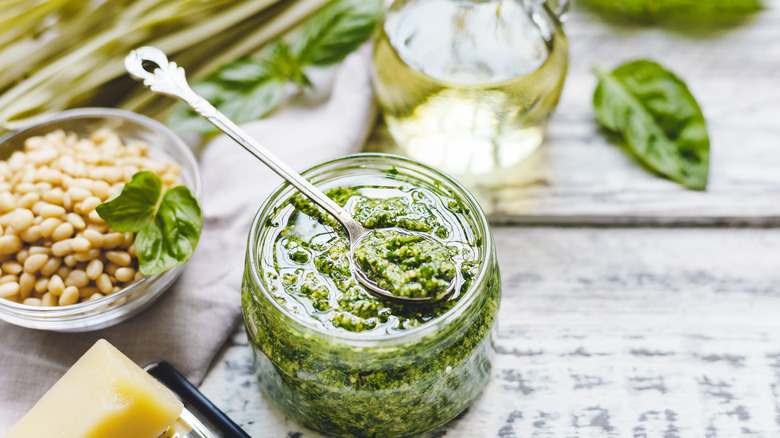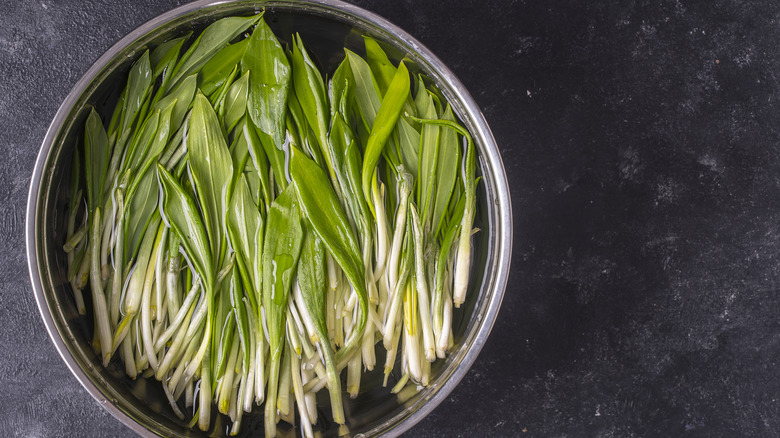Green Garlic Is The Scallion Look-Alike That's Ready For Any Dish
When spring starts springing, our palates start to emerge from their comfy, cozy, stew-season hygge and crave something fresher, lighter, and greener. And if you're perusing the vegetable section at your local grocery store or visiting your farmer's market in its early-season days, you might notice something that looks familiar but, upon closer inspection, isn't what you thought it was. Those white-tipped stalks with long green tubular leaves aren't scallions after all, they're green garlic.
You might know scallions as spring onions or bunching onions, but they're all the same thing: baby onions. Green garlic and spring onions are quite alike in the sense that they're both the young, un-matured shoots of what will become the bulb alliums we know and love as garlic and onion, respectively. That's why they look so similar. And whereas scallions have that mild onion flavor, green garlic will have a mild garlic flavor. You can use them in any dish that calls for garlic, but we love to take advantage of the ephemeral spring crop in recipes that really showcase the mild flavor and bright color.
Recipes that let green garlic shine
The first warming days of spring have us craving light and bright dishes, and green garlic delivers here. One of the best ways to use it is in a simple pesto. If you really love garlic, you can make the pesto completely out of green garlic instead of basil, but for something a little more traditional, try just replacing the cloves of garlic in a basil pesto with green garlic — white bulbs, green shoots and all. Or use it to make a garlic hummus with a green hue, whether you crave a traditional chickpea version or a brighter edamame version.
Green garlic shines in pea dishes, like sweet pea soup with cumin-mint coulis. You could add it to both the soup, instead of the cloves of garlic called for, and to the coulis along with the herbs. Use the white bulbs in the soup, and the green tops in the coulis.
As a dish to transition the seasons, we love green garlic in grain dishes. For farro with sweet peas and ricotta, you can again use the bulbs of green garlic in place of the cloves and the green tops in the lemon herb vinaigrette. If you're looking for something a little heartier and creamier on a stormy spring day, use it in place of ramps (which are often harder to find) in a ramp and asparagus risotto.
A sustainable alternative to ramps
Speaking of ramps, what's the deal there? Ramps are a wild, foraged delicacy that has gained popularity over the years. Like morels, fiddleheads, and truffles, being wild, hand-harvested, and seasonal makes them highly sought after. Their scarcity is as much part of their allure as their light garlicky flavor, but Edible Grande Traverse notes that there's an increasing sustainability problem. Some foragers are overharvesting, either because they're amateur foragers just getting into the scene and don't know any better, or because they're professionals with demands from their clients.
Green garlic might not come with the same mythical allure, but it's more sustainable and also a beautiful harbinger of springtime. In fact, buying green garlic actually prevents agricultural food waste. When planting, farmers tend to over-plant early in the season and then thin later on. This allows them to ensure efficient crop spacing. Maybe there's a dud seed clove that won't grow; planting two right next to each other lets them make sure there is no wasted space in their crop rows. Once the plant takes off, only one can stay. The other gets harvested at this stage in order to give the chosen bulb a chance to live its best life. This thinning is what then either gets dumped into farm compost or sold as green garlic. Though eating more green garlic won't solve all our food sustainability problems, it sure does help — so go ahead and pick up an extra bunch and get cooking.


